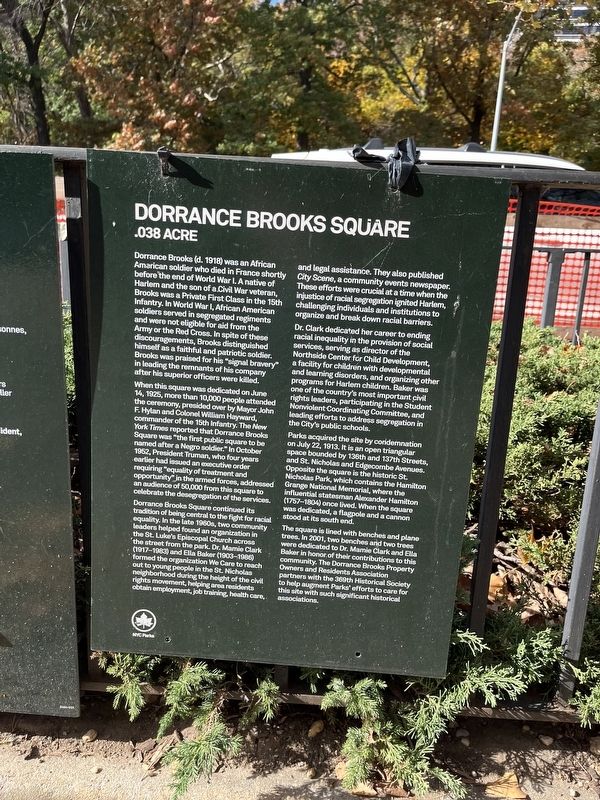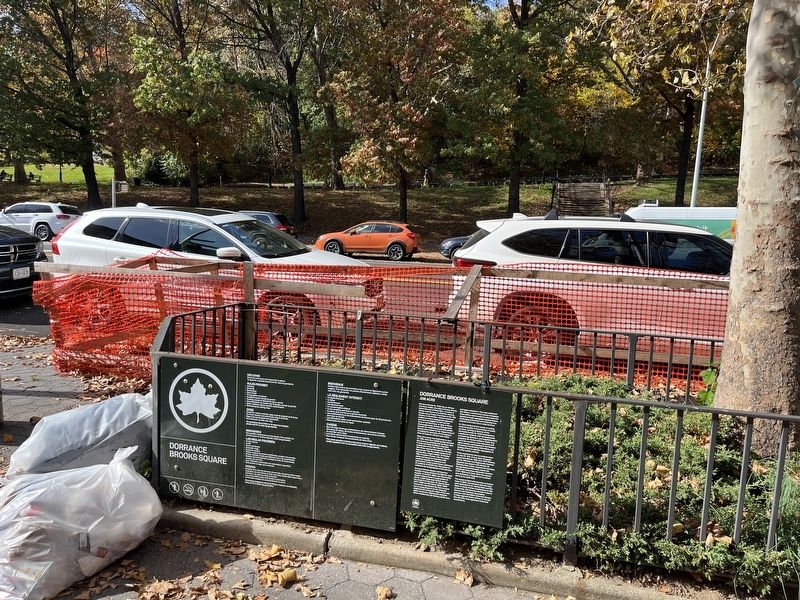Central Harlem in Manhattan in New York County, New York — The American Northeast (Mid-Atlantic)
Dorrance Brooks Square
.038 Acre
Dorrance Brooks (d. 1918) was an African American soldier who died in France shortly before the end of World War I. A native of Harlem and the son of a Civil War veteran, Brooks was a Private First Class in the 15th Infantry. In World War I, African American soldiers served in segregated regiments and were not eligible for aid from the Army or the Red Cross. In spite of these discouragements, Brooks distinguished himself as a faithful and patriotic soldier. Brooks was praised for his "signal bravery" in leading the remnants of his company after his superior officers were killed.
When this square was dedicated on June 14, 1925, more than 10,000 people attended the ceremony, presided over by Mayor John F. Hylan and Colonel William Hayward, commander of the 15th Infantry. The New York Times reported that Dorrance Brooks Square was "the first public square to be named after a Negro soldier." In October 1952, President Truman, who four years earlier had issued an executive order requiring "equality of treatment and opportunity" in the armed forces, addressed an audience of 50,000 from this square to celebrate the desegregation of the services.
Dorrance Brooks Square continued its tradition of being central to the fight for racial equality. In the late 1960s, two community leaders helped found an organization in the St. Luke's Episcopal Church across the street from the park. Dr. Mamie Clark (1917-1983) and Ella Baker (1903-1986) formed the organization We Care to reach out to young people in the St. Nicholas neighborhood during the height of the civil rights movement, helping area residents obtain employment, job training, health care, and legal assistance. They also published City Scene, a community events newspaper. These efforts were crucial at a time when the injustice of racial segregation ignited Harlem, challenging individuals and institutions to organize and break down racial barriers.
Dr. Clark dedicated her career to ending racial inequality in the provision of social services, serving as director of the Northside Center for Child Development, a facility for children with developmental and learning disorders, and organizing other programs for Harlem children. Baker was one of the country's most important civil rights leaders, participating in the Student Nonviolent Coordinating Committee, and leading efforts to address segregation in the City's public schools.
Parks acquired the site by condemnation on July 22, 1913. It is an open triangular space bounded by 136th and 137th Streets, and St. Nicholas and Edgecombe Avenues. Opposite the square is the historic St. Nicholas Park, which contains the Hamilton Grange National Memorial, where the influential
The square is lined with benches and plane trees. In 2001, two benches and two trees were dedicated to Dr. Mamie Clark and Ella Baker in honor of their contributions to the community. The Dorrance Brooks Property Owners and Residents Association partners with the 369th Historical Society to help augment Parks' efforts to care for this site with such significant historical associations.
Erected by NYC Parks.
Topics and series. This historical marker is listed in these topic lists: African Americans • Charity & Public Work • Civil Rights • Military • Parks & Recreational Areas • War, World I. In addition, it is included in the Former U.S. Presidents: #33 Harry S. Truman, and the NYC Parks series lists. A significant historical date for this entry is June 14, 1925.
Location. 40° 49.086′ N, 73° 56.844′ W. Marker is in Manhattan, New York, in New York County. It is in Central Harlem. Marker is at the intersection of Edgecombe Avenue and West 136th Street, on the left when traveling north on Edgecombe Avenue. Touch for map. Marker is at or near this postal address: 28 Edgecombe Ave, New York NY 10030, United States of America. Touch for directions.
Other nearby markers. At least 8 other markers are within walking distance of this marker . Dorrance Brooks Square Historic District (a few steps from this marker); a different marker also named Dorrance Brooks Square (within shouting distance of this marker); a different marker also named Dorrance Brooks Square (within shouting distance of this marker); James Baldwin Lawn (about 400 feet away, measured in a direct line); Shepard Hall (approx. 0.2 miles away); Hamilton Grange (approx. ¼ mile away); a different marker also named Hamilton Grange (approx. ¼ mile away); Hamilton's Eden (approx. ¼ mile away). Touch for a list and map of all markers in Manhattan.
Credits. This page was last revised on January 31, 2023. It was originally submitted on November 10, 2022, by Devry Becker Jones of Washington, District of Columbia. This page has been viewed 64 times since then and 12 times this year. Photos: 1, 2. submitted on November 10, 2022, by Devry Becker Jones of Washington, District of Columbia.

